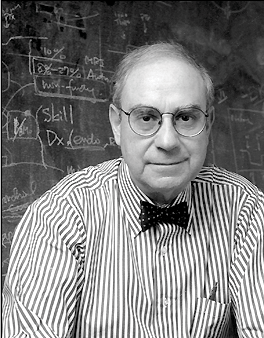Department of Molecular Metabolism
Researching the complex interplay between the major factors underlying metabolic health and disease, including diet, age, environment, and genetics, for the prevention and treatment of widespread chronic diseases.
665 Huntington Avenue
Building 2, 1st Floor
About Armen H. Tashjian Jr.

Armen H. Tashjian, Jr. was a professor of toxicology, emeritus, and the former chair of the then-named Department of Molecular and Cellular Toxicology at the Harvard T.H. Chan School of Public Health, Tashjian was celebrated for his neuroendocrine research. His work contributed to a life-saving test for a pre-cancerous condition associated with inherited thyroid cancer and played a key role in the development of two drugs for the treatment and prevention of osteoporosis. He also was professor of biological chemistry and molecular pharmacology, emeritus at Harvard Medical School. He received the Harvard Chan School Faculty Emeritus Award of Merit for his significant contributions to the field of pharmacology.
Tashjian graduated from Yale University in 1953 and earned his MD from HMS in 1957. After working at the NIH, he returned to HMS in 1961 as well as the Harvard School of Dental Medicine, where he became an expert in parathyroid hormone and calcium metabolism. Tashjian was appointed professor of toxicology at Harvard School of Public Health in 1978. Then-Dean Howard Hiatt tapped him to head a new Laboratory of Toxicology, and Tashjian began to enthusiastically build a cadre of molecular and cellular biologists. The lab developed into the Department of Molecular and Cellular Toxicology, which he chaired.
He was a leading figure in guiding the development of two major drugs in the bone field: raloxifene as a bone resorption inhibitor, used to help prevent and treat osteoporosis and in the prevention of breast cancer, and PTH as an anabolic agent.
Tashjian trained more than 100 graduate students and postdoctoral fellows. His leadership contributions extended beyond his own research and students. He was president of the International Bone and Mineral Society from 1989-1992 and vice president from 1986-1989, reflecting the great respect for him internationally in the bone field. He was president of the American Society for Bone and Mineral Research from 1989-1990, and received the Astwood Award from the Endocrine Society for basic scientific discoveries in skeletal biology and neuroendocrinology, as well as the Endocrine Society’s Distinguished Leadership Award.
He was a person of great integrity and scholarship, much loved by his many friends and colleagues, a man of great talent and intellect, but reserved and indeed humble, and with an ever-present sense of humor.
He passed away on July 3, 2009.